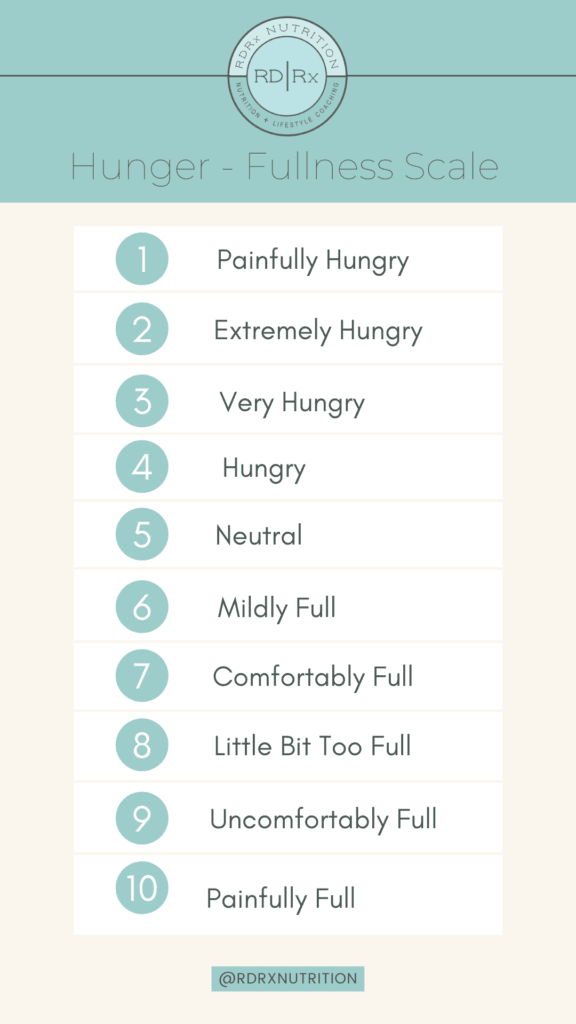Diet culture wants us to give morality to food but in reality, food is neutral and ALL foods can be enjoyed in our diet. Shifting our mindset away from labeling foods as “good” and “bad” takes time, but it is essential for building a healthy relationship with food. Here are a few tips to help you break the “Good Food” “Bad Food” Mentality.
Take Back the Power You Gave Your ‘‘Fear” Foods
Food doesn’t deserve to have power in our lives to shame us or control us. WE are experts of our body and we deserve the power over food. Labeling a food as bad increases your desire to eat it. Taking that label away allows you to enjoy that food and stop eating when it no longer satisfies you.
Action Steps
Can you name some foods that you have a fear of eating?
How can you remove that fear from the food? Here are a couple of suggestions
Can this food help create a balanced meal?
- Give yourself unconditional permission to eat it.
- Take the shame away. Remind yourself that it is okay to eat until you are satisfied and full.
- Allow yourself to eat the food when you are craving it. Our bodies crave food for so many different reasons.
Get in Touch With Your Hunger and Fullness Cues
If you are super hungry, a few cookies won’t fill you up so of course you want to keep eating them. This isn’t a failure on your part! Enjoy cookies after a meal for a nice dessert. Coincidentally, if you are uncomfortably full and still want the cookie – be mindful of your emotions, ask yourself- do I really want it? Am I just bored? Anxious? Am I just eating it because it is there?
If you still decide to eat it- that is okay!
Action Steps for to let go of Good Food Bad Food Mentality
- Print out this hunger and fullness scale and pin it on your fridge!
- Assess your hunger and fullness before the meal
- Take a break in the middle of the meal/snack
- Are you still enjoying it?
- Assess your hunger and fullness after. How are your emotions?

This can seem like a daunting task but this is a great mindful exercise to start doing once a week. The more you do it, the less effort it takes!
If you want to learn more about mindfulness watch this youtube video – Why Mindfulness Is a Superpower: An Animation
Understand Your Cravings and Desires for Certain Foods
Your cravings and desires are valid and backed by science. Your body is smart, if it lacks nutrients- it is going to tell you one way or another. For example, If you get less sleep your body craves energy so you will likely be craving easy digestible carbs for fast energy. If you have little to no food during the day, you may have more intense cravings to make up for the lost calories. Your body is working for you-not against you!
Action Step
- Listen to your cravings next time you have a strong desire for a specific food- are you tired? Hungry? Have you not eaten enough? Are you stressed? Is it for pleasure?
This is another great mindfulness exercise!
Scrap the Scarcity Mentality- Give Yourself Unconditional Permission to Eat
The once-scarce, off-limits food is now available all the time, there’s no rush or pressure to eat (or binge) on it. This is one of ten principles of Intuitive Eating and is very important when it comes to healing your relationship with food.
Action Steps
- Truly give yourself permission to eat next time you get a craving
- Head to my blog for more information on the 10 principles of intuitive eating
Reintroduce One ‘Fear’ Food at a Time
Adding all foods at once can be overwhelming. Practice the previously mentioned mindfulness exercises with one food at a time. When you feel comfortable with that food, move on to a new one. One step and a time!
Action Step
- Sit down and observe taste, fullness, and satisfaction with no judgment or shame.
Prioritize Non-Weight-Based Health Goals
Despite what diet culture says, there are so many factors when it comes to our weight that are out of our control. What are factors in your life that you can control? What are non weight goals you have? Examples include- getting enough sleep, having enough downtime, engaging in self-care and moving your body in ways that feel good.
Action Step
- Write a list of all your health goals
- Do you value these over a number on the scale?
Use Words like ‘Staple Foods’ and ‘Play Foods’
Try to catch yourself when you go to label a food as bad-can you call it play food? The “good food” “bad food” mentality can be tough to break. Food is not always consumed for its nutrients. We are allowed to enjoy food for things other than its nutrients. It is okay to eat for just joy and play. It is only a concern when it is our only coping mechanism.
Action Step
Practice this by making a list of staple foods and play food you enjoy without using the the “good food” “bad food” mentality.
Remember to give yourself compassion! Habits are hard to break. It will require dedication to shift your mindset away from thinking about foods as good or bad. Take one step at a time to build on new habits.

Created by Carissa Kiefer, UAA Dietetic Intern, RD2B
Thank you so much for your website. I learned no good food/bad food in an eating disorder clinic 8 years ago. Eating disorders are tricky. Mine reared it’s ugly head again and I needed help like that which you provide.